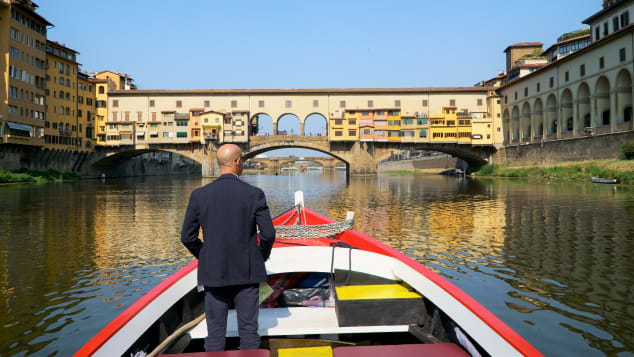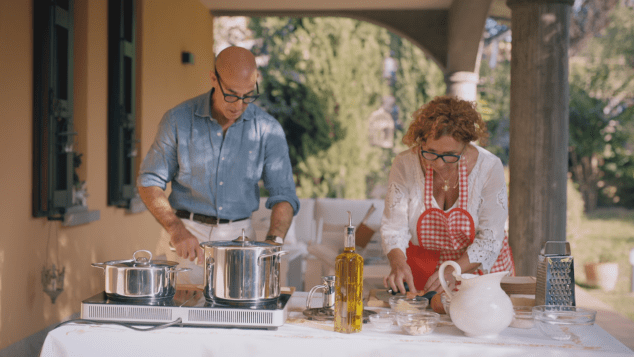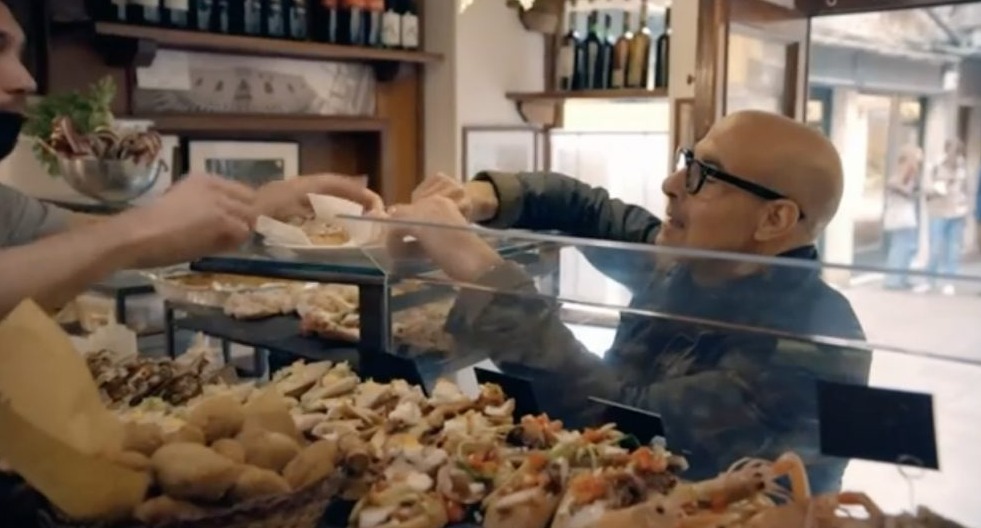
We use cookies
We use cookies and other tracking technologies to improve your browsing experience on our website, to show you personalized content and targeted ads, to analyze our website traffic, and to understand where our visitors are coming from.


Elisabetta Moro and Stanley Tucci eat pizza in Naples
Stanley Tucci has described his travel and food show (now in its second season) as a tribute to his ancestral homeland, his intention to show Americans the wealth of Italy’s culinary, wine, historical and cultural heritage.
Season 1 begins in Campania, where Stanley starts with local products in Naples, Ischia and the Amalfi coast discovering their roles in the most famous of dishes.
Episode 2 is in Rome where culinary delights such as a sweet maritozzo or a creamy pasta alla carbonara can be found in the shade of architectural marvels of the Eternal City like the Pantheon.
In Emilia-Romagna for Episode 3, Tucci watches cheese production in the town of Zocca (province of Modena) and vinegar in Modena, tastes mortadella in Bologna, visits the Artusi house in Forlimpopoli (province of Forlì-Cesena), then travels to Rimini, birthplace of Federico Fellini.
In Episode 4, between a plate of risotto and a dish of polenta, he moves to the city of Milan, across the Orobian Alps and to lake Como.
Tuscany is the star of Episode 5, where Tucci visits the lively Sant'Ambrogio market in Florence along with the city’s ancient restaurants and osterias and the central market, before heading off to Livorno (Leghorn).
Season 1 ends in Sicily, with a trip to Bagheria (province of Palermo) to try spaghetti alla bottarga, a visit to the vineyards of Vittoria (province of Ragusa), dinner in the port city of Catania, a taste of timballo in Palermo and an encounter with a family from Lampedusa.

Stanley Tucci on Ponte Vecchio in Florence
Season 2 opens on the canals of Venice, where Tucci spends time at the bacari, the little hostelries where drinks are accompanied by cicchetti (small tasting plates). In addition to the centre of Venice, locations include the lagoon islands of Torcello and Mazzorbo, and even the area of Campagna Lupia for a duck hunt.
Episode 2 focuses on the city of Turin, in Piedmont, where the crew spent 10 days and shot in the squares of San Carlo, Carignano and Castello, on lungo Po, at the monte dei Cappuccini, the Porta Palazzo and central markets, the Lingotto and numerous historic, iconic restaurants in the city. Tucci and his crew also visited Nizza Monferrato in the Langhe and the area of Vercelli discovering the idiosyncrasies and delights of the local wine and cuisine culture. The episode ends at lake Blu in Valle d’Aosta, where Tucci eats a fondue in the hamlet Breuil-Cervinia di Valtournenche.
Episode 3 in Umbria, gives Tucci the opportunity to try porchetta in Montefalco with chef Giorgio Barchiesi. He stops in Norcia to try the dried meats in a typical norcineria. Then he goes to San Pietro a Pettine in Trevi (province of Perugia) to visit 21-year-old truffle farms. The focus in Orvieto is the historical centre along with characteristic restaurants and the piazza del Popolo market where he finds the best of Umbrian cheeses and meats. Before leaving Umbria, Tucci goes to Città della Pieve, where Colin and Livia Firth manage a sustainable farm of 60 acres.

Elisabetta Moro and Stanley Tucci eat pizza in Naples
Stanley Tucci has described his travel and food show (now in its second season) as a tribute to his ancestral homeland, his intention to show Americans the wealth of Italy’s culinary, wine, historical and cultural heritage.
Season 1 begins in Campania, where Stanley starts with local products in Naples, Ischia and the Amalfi coast discovering their roles in the most famous of dishes.
Episode 2 is in Rome where culinary delights such as a sweet maritozzo or a creamy pasta alla carbonara can be found in the shade of architectural marvels of the Eternal City like the Pantheon.
In Emilia-Romagna for Episode 3, Tucci watches cheese production in the town of Zocca (province of Modena) and vinegar in Modena, tastes mortadella in Bologna, visits the Artusi house in Forlimpopoli (province of Forlì-Cesena), then travels to Rimini, birthplace of Federico Fellini.
In Episode 4, between a plate of risotto and a dish of polenta, he moves to the city of Milan, across the Orobian Alps and to lake Como.
Tuscany is the star of Episode 5, where Tucci visits the lively Sant'Ambrogio market in Florence along with the city’s ancient restaurants and osterias and the central market, before heading off to Livorno (Leghorn).
Season 1 ends in Sicily, with a trip to Bagheria (province of Palermo) to try spaghetti alla bottarga, a visit to the vineyards of Vittoria (province of Ragusa), dinner in the port city of Catania, a taste of timballo in Palermo and an encounter with a family from Lampedusa.

Stanley Tucci on Ponte Vecchio in Florence
Season 2 opens on the canals of Venice, where Tucci spends time at the bacari, the little hostelries where drinks are accompanied by cicchetti (small tasting plates). In addition to the centre of Venice, locations include the lagoon islands of Torcello and Mazzorbo, and even the area of Campagna Lupia for a duck hunt.
Episode 2 focuses on the city of Turin, in Piedmont, where the crew spent 10 days and shot in the squares of San Carlo, Carignano and Castello, on lungo Po, at the monte dei Cappuccini, the Porta Palazzo and central markets, the Lingotto and numerous historic, iconic restaurants in the city. Tucci and his crew also visited Nizza Monferrato in the Langhe and the area of Vercelli discovering the idiosyncrasies and delights of the local wine and cuisine culture. The episode ends at lake Blu in Valle d’Aosta, where Tucci eats a fondue in the hamlet Breuil-Cervinia di Valtournenche.
Episode 3 in Umbria, gives Tucci the opportunity to try porchetta in Montefalco with chef Giorgio Barchiesi. He stops in Norcia to try the dried meats in a typical norcineria. Then he goes to San Pietro a Pettine in Trevi (province of Perugia) to visit 21-year-old truffle farms. The focus in Orvieto is the historical centre along with characteristic restaurants and the piazza del Popolo market where he finds the best of Umbrian cheeses and meats. Before leaving Umbria, Tucci goes to Città della Pieve, where Colin and Livia Firth manage a sustainable farm of 60 acres.

Stanley Tucci learns to make ragù alla bolognese with cook Barbara Asioli
Stanley Tucci’s journey puts the culinary idiosyncrasies of Italy’s different regions on display, showing how the local prime materials make the difference.
In Campania, Tucci discovers mozzarella and its production process, is won over by Neapolitan pizza and pizza fritta (fried pizza), travels to Ischia where he tastes coniglio all'ischitana (Ischian rabbit), and continues onto spaghetti alla Nerano and delizia al limone on the Amalfi coast.
Roma welcomes the actor with an expresso and the capital’s maritozzi and takes him to the Pantheon for rigatoni all'amatriciana and the search for the perfect carbonara. The Roman tour continues to a sweetbreads restaurant where he eats a frittata with pureed chicken offal, Roman tripe, wagyu tartare and oxtail balls with peanut sauce, wild celery and cocoa powder. The episode couldn’t end without a fried artichoke and Rome’s famous pasta cacio e pepe.
In Emilia-Romagna, Tucci eats parmesan cheese, produced with local cow milk with honey, sambuca flower and balsamic vinegars. He tries mortadella in Bologna, traditional balsamic vinegar in Modena, ragù alla bolognese in casa Artusi, and ends in Rimini eating cappelletti and strozzapreti.
In Milan, Tucci is served veal cutlets and saffron risotto in addition to the classic aperitif. In the Orobian Alps, he witnesses the process behind bitto storico ribelle, a cheese with two thousand years of history. He also makes pizzoccheri, a buckwheat pasta.
In Tuscany, Tucci wanders the street markets in search of ingredients for bistecca alla fiorentina and “la cucina povera” (local peasant cooking). A wide Tuscan menu takes shape amidst the osterie of the historical centre, featuring: ribollita, pappa al pomodoro and panzanella, accompanied by good wine and followed by a dessert of vin santo with the typical almond biscuits known as cantucci. Livorno presents him with a frittella a base di farina di ceci.

Stanley tastes the “cicchetti” (small tasting plates) of Venice
In Venice, the opening location of Season 2, Tucci is won over by the city’s small tasting dishes “cicchetti”, and traditional recipes like risotto al nero di seppia and a good tiramisù. He doesn’t miss out on cocktails and a taste of dorona, a wine produced only on the island of Mazzorbo.
His gastronomic tour of Turin begins with a bicerin, a drink famous since the 1700s which has three layers: coffee, chocolate, cream, each at a different temperature. Tucci comes across the specialities of Piedmont in family-run restaurants and Michelin starred chefs: the ancient dish of stufato known as the la finanziera; bagna cauda made with a base of anchovies and garlic; the risotto of Vercelli, with coffee, beer and grana padano; the special aroma of white truffle; and the unusual characteristics of barolo delle Langhe.
A quick stop in Valle d’Aosta adds a fondue, with a fontina cheese base, to his culinary journey of discovery.
Albeit a small region, Umbria has a rich culinary tradition, starting with oven roasted porchetta, stuffed with sausage and aromatic herbs. Dinner with an all-female group of boar hunters gives him the opportunity to try ragù al cinghiale, while the local norcinerie and restaurants offer a vast range of dried and cured meats and cheeses. He is served pigeon in Orvieto, part braised in the traditional style with the rest marinated in soy sauce and cooked in vacuum bags. While staying at the Firths’ farm he tries aubergine caviar: roasted aubergine with garlic, olive oil, salt and tarragon.

Stanley Tucci, American actor and director, travels Italy, discovering the country’s food, history and culture, in traditional family cooking and typical local restaurants region by region.
Do you want to be deleted? Send an email to: info@italyformovies.it
Do you want to be deleted? Send an email to: info@italyformovies.it
